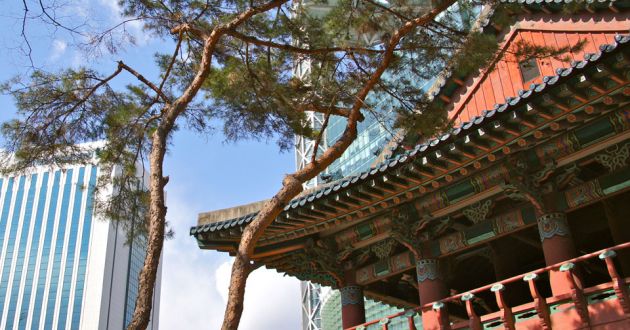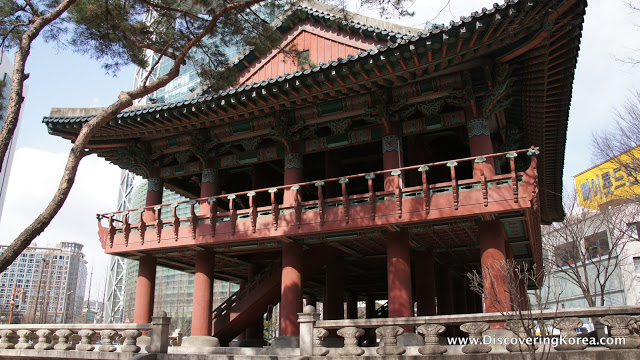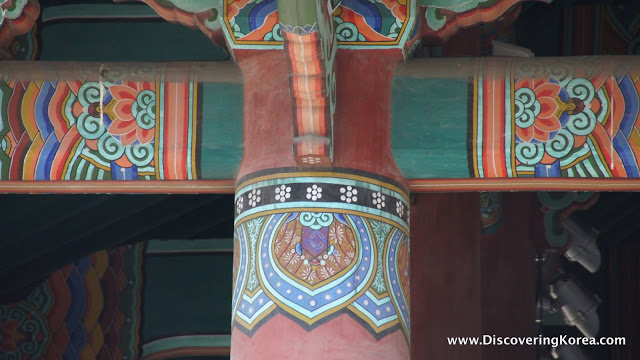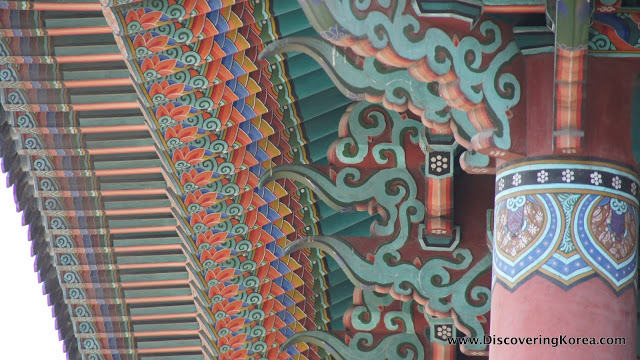Although there are many wider boulevards lined by much taller buildings in Seoul, Jongno remains one of the city’s most important east-west thoroughfares.

And from early on, the vital route has been home to the Bosingak Belfry (보신각), a traditional piece of architecture that dates from 1396. The open-sided, two-story Bosingak Belfry is actually a belfry.
In fact, both the street and the central district in which it’s located are named after the “jong” or grand bronze bell that’s located under its eaves. In fact, “Jongno” simply means “Bell Road.”
Designated Seoul Monument No. 10, the Bosingak Belfry was erected in the 5th year of King Taejo’s reign to notify the citizens of Seoul of the opening and closing times of the city gates, as well as to announce emergencies, such as fire.
For example, at 4-o’clock each morning, or what was called “Paru,” the bell was rung 33 times, which symbolized the 33 cheon, or heavens of Buddhism.

At “Injeong” or 7-o’clock each evening, the bell was rung 28 times to mark the closing of the gates and the start of a general curfew. The number 28 represented the location of star constellations.
Although the Bosingak Belfry was initially built in what is now the Insa-dong neighborhood, it was relocated to its current place during King Taejong’s reign.
Over the centuries, the grand structure was destroyed by fire or attack, but was subsequently rebuilt. It was during King Sejong’s reign that it took its current size – six by five kan.

Kan refers to the space between columns. During the reign of King Gojong around the turn of the 20th century, the belfry was reconstructed and renamed Bosingak. The pavilion was rebuilt again in the modern era. The current structure dates from 1979.
Of course, the Bosingak Belfry’s primary purpose is to hold a huge bronze bell. When the original melted in an early fire, a new one was cast in 1468.
Today it is designated Seoul Treasure No. 2 and is exhibited in the National Museum of Korea in Seoul. In its place is a bell that was mounted recently, in 1985.

The Bosingak Belfry’s color palette is dominated by its red columns and second floor balcony, and the largely green roof eaves and brackets are accented by colorful details.
Set atop a stone foundation with an elegant stone rail, it’s a majestic structure that holds its own even as glass towers have risen around it.
Perhaps Bosingak Belfry is best viewed at night, when it’s under lit by scores of lamps. But should you prefer to stop by during the day, I suggest trying to schedule your visit during one of the daily bell-ringing ceremonies that started up just a couple of years ago.
What’s more, guests can even sign up online to be among four people to ring the bell 12 times at 12-o’clock in the afternoon. Following traditional military music and the ringing ceremony, guards dressed in royal vestments march back to Deoksugung Palace.

Finally, while the bell no longer tolls to mark each day’s start or end, Bosingak Belfry remains the site of a big festival on New Year’s Eve, when thousands of Seoulites gather to hear its bell toll 33 times to ring in a New Year.
Admittedly it’s not quite as big a draw as New York’s Times Square, but Bosingak Belfry is certainly a place with a much longer tradition!
For Your Information..
| Open: | Open 24 Hours, Bell-ringing ceremony occurs Tue-Sun from 11:30-12:30. |
| Admission Price: | Free |
| Address: | Seoul Jongno-gu Gwancheol-dong 45-5 |
| Directions: | Jonggak Station (#131) on Line 1, Exit 4 |
| Phone: | 02-1220 |
| Website: |
About Matt Kelley
Matt Kelly is native of the US Pacific Northwest and is half-Korean by ethnicity. He lived in Korea for five years and has written hundreds of travel guides for Wallpaper, TimeOut, the Boston Globe and Seoul Magazine and was a host for several different variety shows on Korean radio and television.
